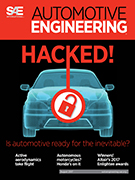Journal Article
(R)evolution of E/E Architectures
2015-04-14
2015-01-0196
Functionalities such as automated driving, connectivity and cyber-security have gained increasing importance over the past few years. The importance of these functionalities will continue to grow as these cutting-edge technologies mature and market acceptance increases.






